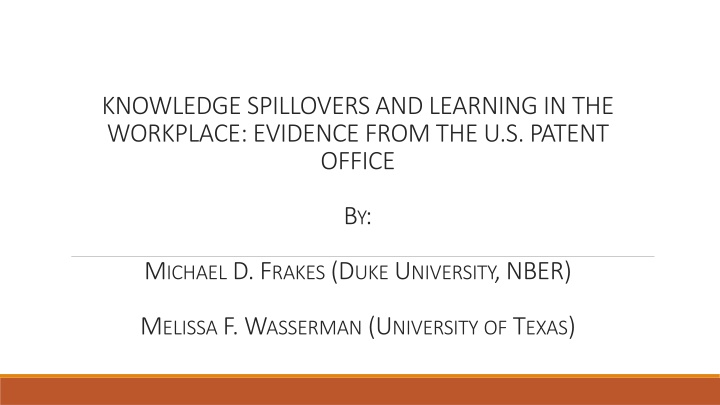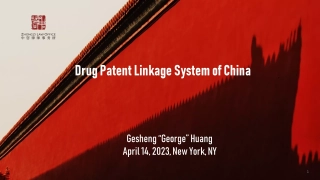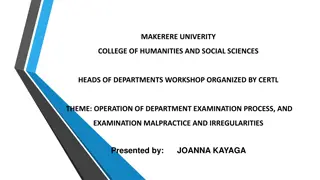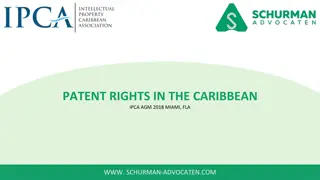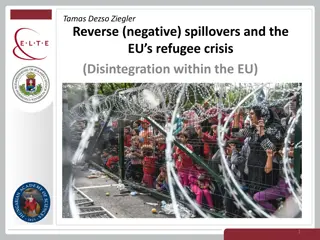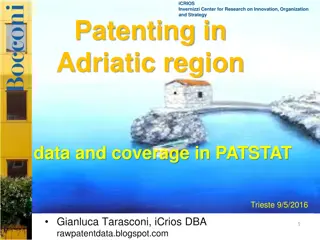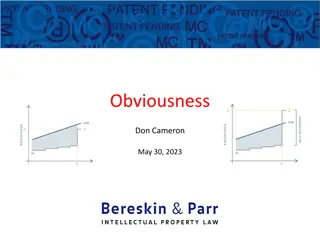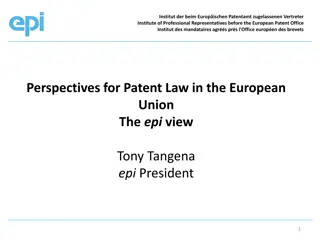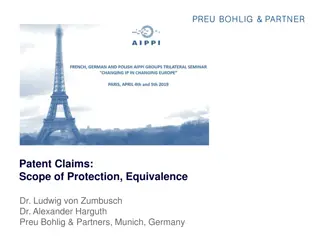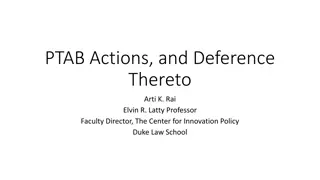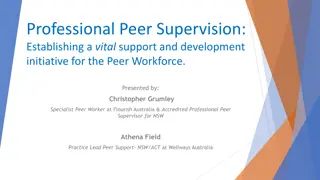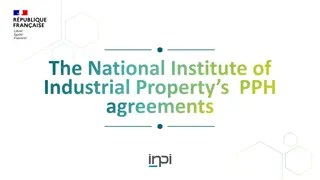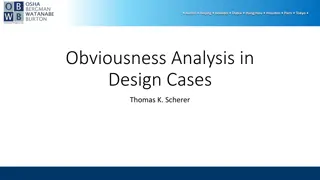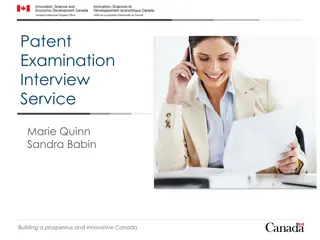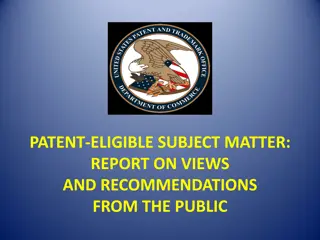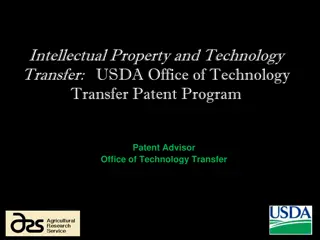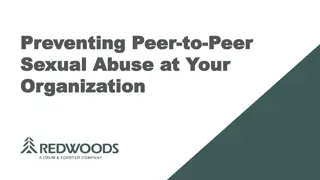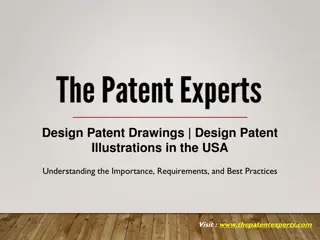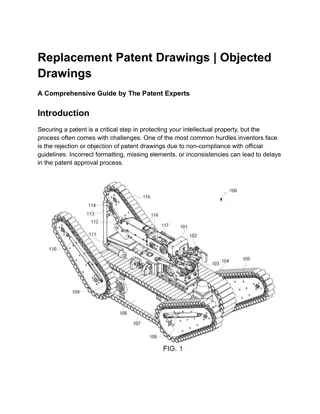Knowledge Spillovers and Peer Effects in Patent Examination
This study examines the impact of peer effects on patent examiners' behavior in granting applications, focusing on knowledge spillovers and learning in the workplace. Through empirical exercises and data analysis, the research seeks to understand the association between the likelihood of application approval and the grant rates of peer groups, shedding light on the mechanisms influencing patent examination decisions.
Download Presentation

Please find below an Image/Link to download the presentation.
The content on the website is provided AS IS for your information and personal use only. It may not be sold, licensed, or shared on other websites without obtaining consent from the author.If you encounter any issues during the download, it is possible that the publisher has removed the file from their server.
You are allowed to download the files provided on this website for personal or commercial use, subject to the condition that they are used lawfully. All files are the property of their respective owners.
The content on the website is provided AS IS for your information and personal use only. It may not be sold, licensed, or shared on other websites without obtaining consent from the author.
E N D
Presentation Transcript
KNOWLEDGE SPILLOVERS AND LEARNING IN THE WORKPLACE: EVIDENCE FROM THE U.S.PATENT OFFICE BY: MICHAELD. FRAKES(DUKEUNIVERSITY, NBER) MELISSAF. WASSERMAN(UNIVERSITY OF TEXAS)
Motivation Contribution to patent examiner literature Patent system plays an important role in shaping the growth and direction of technological development. Thus understanding what impacts the behavior of patent examiners in granting applications is of great interest. Contribution to literature on peer effects in economics Small but growing literature in the workplace: Open questions: How do magnitude of peer effects in workplace compare with supervisor effects? Mechanism? Peer pressure vs. knowledge spillovers/learning?
Background on Patent Examination Peer groups Art Units (our interviews confirm examiners in Art Units are generally in proximity of each other) Acknowledge that peer groups may go beyond Art Units, in which case our estimates may be seen as lower bound We will take care to differentiate among three types of individuals within Patent Office: Assistant Examiners Primary Examiners SPEs Telecommuting program Creates possibility of variation within Art Units in social accessibility Scope for learning in conducting obviousness analysis vs novelty analysis
Data Collected data on all 1.4 million utility patent applications from PAIR from 2001-2012 filed on or after March 2001 and published and disposed by July 2012 Includes which examiner assigned to the application, whether the application ultimately granted, the types of rejections made FOIA the PTO for annual roster indicating the GS-level, experience, and date of commencement of telework (which we use to test whether the mechanism is learning versus peer pressure) Patent citations data (for patents issued between 2000 and 2010) (which is also used to test whether the mechanism is learning versus peer pressure)
Methods Key Empirical Exercise: explore association between likelihood of given application being allowed and the inherent grant rates of the peer group of examiners surrounding the examiner in charge of the given application. An exercise of this sort confronts a number of well-known econometric problems: Endogenous sorting of like examiners Solution: examiner fixed effects Reflection problem simultaneity issue (Manski 1993) Are my peers affecting me or the other way around? Various Solutions: use inherent grant rates of peer groups rather than grant rate at the time of decision Common unobservables e.g., supervisory policies that impact everyone in peer group alike Various solutions: SPE fixed effects or Art-Unit-by-year fixed effects (above solutions to reflection problem also help with this concern)
Methods (contd)Mechanism? Other Challenge: Mechanism is it learning or peer pressure If the mechanism is learning then we look for certain markers based on the following predictions: First prediction If learning, one might predict peers to be most influential early on in an affected examiner s career at Patent Office when they are most impressionable and developing their examining style than later on in their career where their practice styles may be entrenched Second prediction If learning, one might predict that new examiners more influenced by seasoned peers than similarly junior peers Third prediction If learning, one might predict that styles learned during initial years will persist Fourth prediction If learning, then does some of the learning comes through the types of prior art cited.
Results Summary Examiner grant rates when new at Patent Office are strongly associated with composition of peers at that time 1 standard deviation increase in inherent peer grant rate associated with a roughly 0.15 standard deviation increase in own grant rate Fi0 to 100 percentage points in the mean inherent grant rate of an examiner s peer group is associated with roughly 43 percentage point increase in own grant rate Early career effects are stronger when we construct peer scores based on the inherent grant rate of the more experience co-workers surrounding her Influence of peer composition weakens later in examiner s career (though doesn t totally dissipate). Evidence suggestive of persistence in effects of temporary changes in peer composition, consistent with learning.
Results Summary Magnitude of Effects Assistant examiner effects just as strong as primary examiner effects Assistant examiner effects stronger than SPE effects Mechanism behind Learning? Examiners are more significantly more likely to cite to a prior art reference that is among set of pet prior art of peer examiners when those peers are not telecommuting relative to when those peers are telecommuting Moving Beyond the Grant Rate Claim narrowing evidence that little association of claim narrowering for a given patent and inherence claim narrowing of peers during first 2 years but there is an associated years 3+
Results Summary Falsification Checks Peer influences are weaker when constructing peer scores based on the set of examiners that telecommute versus those that don t Stronger signs of peer-based learning and influence in the case of obviousness grounds relative to the case of rejections based on novelty
Conclusion Initial conditions matter significantly (consistent with Frakes and Wasserman 2016) Information may be useful for Patent Office in allocating examiners, determining training policies, etc. This especially true of outliers Results suggest that proximity matters a lot Implication: if peer effects steered so as to generate positive knowledge spillovers, there may be consequences to push towards telecommuting At least these harms from telecommuting should be weighed against its benefits when setting telecommuting policies
EFFECTSOF PEERAND SUPERVISOR GRANTING TENDENCIESON ASSISTANT EXAMINER GRANT RATES, BY YEARS OF ASSISTANT EXAMINER EXPERIENCE (2) (3) (4) (5) (6) (1) Pure Peer Effects (Assistant Examiner Effects) Quasi-Supervisory Effects (Primary Examiner Effects) Supervisory Effects (SPE Effects) 0.426*** (0.075) 0.401*** (0.057) 0.482*** (0.104) 0.341*** (0.056) 0.314*** (0.078) 0.196*** (0.061) Peer Score (Omitted: Peer Score X 0-2 Years Experience) -0.173*** (0.031) -0.161*** (0.022) -0.219*** (0.041) -0.210*** (0.029) -0.135*** (0.049) -0.088*** (0.029) Peer Score X 2-4 Years Experience -0.182*** (0.049) -0.191*** (0.037) -0.298*** (0.068) -0.312*** (0.049) -0.190** (0.077) -0.169*** (0.051) Peer Score X 4-6 Years Experience N 153906 415575 153584 413499 68063 183,268 Balanced Sample? YES NO YES NO YES NO
EFFECTOF INHERENT PEER GRANTING TENDENCIESON ASSISTANT EXAMINER GRANT RATE, BY YEARSOF EXPERIENCEOFTHE AFFECTED ASSISTANT EXAMINER of 100% Increase in Inherent Peer Grant Score 95% Confidence Interval of Estimated Effect on Assistant Examiner Grant Rate .5 .4 .3 .2 .1 0 <2 Years 2-4 Years 5-6 Years 7+ Years Experience Group of Affected Assistant Examiner
(2) (3) (4) (5) (6) (7) (8) (1) 0.327*** (0.067) 0.443*** (0.062) 0.329*** (0.048) 0.486*** (0.074) 0.517*** (0.089) 0.906*** (0.213) 0.334*** (0.088) 0.456*** (0.056) Peer Score (Omitted: Peer Score X 0-2 Years Experience) -0.148*** (0.048) -0.214*** (0.069) -0.122*** (0.036) -0.216*** (0.049) -0.177*** (0.027) -0.199*** (0.043) -0.122*** (0.030) -0.124*** (0.046) -0.140*** (0.032) -0.136*** (0.050) -0.183*** (0.052) -0.354*** (0.082) Peer Score X 2-4 Years Experience -0.163*** (0.034) -0.190*** (0.020) Peer Score X 4-6 Years Experience -0.165*** (0.055) -0.236*** (0.032) Peer Score X 7+ Years Experience N -0.251*** (0.048) 521275 - - - - - - - 145804 152745 152841 150504 153905 153905 68063 Art-Unit-by- Year Fixed Effects Art-Unit-by- Bi-Year Fixed Effects Treatment of Art Unit and Time Effects Art Unit and Year Effects Art Unit and Year Effects Art Unit and Year Effects Art Unit and Year Effects Art Unit and Year Effects Art Unit and Year Effects SPE Dummies? YES NO NO NO NO NO NO NO Balanced or Unbalanced? Balanced Balanced Balanced Balanced Balanced Balanced Balanced Unbalanced Grant Rate for Years Prior to t Estimated Examiner Fixed Effects Empirical Bayesian Estimator Construction of Peer Grant Score at Year t Lifetime Grant Rates Lifetime Grant Rates Lifetime Grant Rates Lifetime Grant Rates Lifetime Grant Rates Limit to Art-Unit-Year Cells With Data on SPE Grant Rate? NO NO NO NO NO NO YES NO
Specifications with Leads and Lags (2) (3) (4) (5) (6) (7) (1) 0.057 (0.061) 0.056 (0.041) 0.009 (0.042) 0.043 (0.044) 2-Year Lead Score - - - Contemporaneous Peer Score 0.302*** (0.082) 0.332*** (0.064) 0.151*** (0.069) 0.253*** (0.079) 0.234*** (0.048) 0.112** (0.052) 0.191*** (0.069) 2-year Lagged Peer Score 0.118* (0.060) 0.141*** (0.043) 0.138*** (0.053) 0.139** (0.068) - - - N Balanced Sample (Over first 6 Years of Career)? 131575 409752 388813 116812 374417 360708 286041 YES NO NO YES NO NO NO Limit to Examiners Beyond their Second Years NO Limit to Examiners Beyond their Second Years YES Limit to Examiners Beyond their Second Years YES Limit to Examiners in their 3rd-6th Years Other Restrictions? NO NO NO SPE Effects? NO NO YES NO
EFFECTSOF PEER GRANTING TENDENCIESON ASSISTANT EXAMINER GRANT RATES: VARIOUS FALSIFICATION EXERCISES (2) (3) (4) (5) (6) (1) Peer Group: Assistant Examiners With Less than 2 Years of Experience Peer Group: Assistant Examiners With 2 or More Years of Experience Peer Group: Non- Teleworking Assistant Examiners (2006+) Peer Group: Teleworking Assistant Examiners (2006+) Incidence of Any Obviousness Rejection Incidence of Any Lack-of-Novelty Rejection 0.098** (0.047) 0.400*** (0.072) 0.462*** (0.075) 0.192*** (0.073) -0.035 (0.079) 0.244*** (0.082) Peer Score (Omitted: Peer Score X 0-2 Years Experience) -0.082*** (0.034) -0.185*** (0.031) -0.166*** (0.038) Peer Score X 2-4 Years Experience -0.119*** (0.035) 0.021 (0.050) -0.116*** (0.057) -0.065* (0.048) -0.201*** (0.049) -0.297*** (0.055) Peer Score X 4-6 Years Experience -0.133*** (0.059) 0.032 (0.080) -0.232*** (0.069) N 136654 136701 135314 152659 131629 85473
RELATIONSHIPBETWEEN LIKELIHOODTHAT ASSISTANT EXAMINER WILL CITETO SETOFPET / FAVORITE PATENTSOF HER PEER GROUPANDAN INDICATOR VARIABLEFORTHE NON- TELECOMMUTING STATUSOFTHAT PEER GROUP (RELATIVETOTHE TELECOMMUTING STATUSOF THAT PEER GROUP) (2) (1) 0.003*** 0.004*** Non-Tele-commuting Peer Group (0.001) (0.001) N 326460 326460 Coefficient of Non-Tele-commuting Peer Group 0.19 0.25 as a Fraction of Mean of Dependent Variable Sample of Issued Patents with Information on Telecommuting Peer Group Sample Stacked on Sample of Issued Patents with Information on Non- Telecommuting Peer Group Parameterization of Controls for Count of Telecommuting and Non- Relevant Examiner Count and its Dummies for Different Quartiles of Telecommuting Examiners Square Relevant Examiner Count Issued Patent Fixed Effects? YES
EFFECTOF INCREASEIN INHERENT PEER GRANTING TENDENCIESON NEW EXAMINER GRANT RATE AT DIFFERENT PERCENTILESOF PEER GRANT SCORES Percentile of Peer Grant Score within Art Unit .8 Effect on New Examiner Grant Rate of an Increase in Peer Grant Score at Indicated .6 .4 .2 0 0 20 40 60 80 100 Percentile of Peer Grant Score (Within Art Unit) Peer Effect: Confidence Interval Peer Effect: Mean
3 2 Density 1 0 -1 -.5 0 .5 Estimated Examiner Fixed Effects
